stop start RENAULT SCENIC 2011 J95 / 3.G Engine And Peripherals EDC16C36 Workshop Manual
[x] Cancel search | Manufacturer: RENAULT, Model Year: 2011, Model line: SCENIC, Model: RENAULT SCENIC 2011 J95 / 3.GPages: 431, PDF Size: 2.03 MB
Page 18 of 431

13B-18V9 MR-372-J84-13B450$050.mif
DIESEL INJECTION
Fault finding – Features13B
EDC16 C36
Program No.: 91
Vdiag No.: 44, 4C, 48,
50, 54, 58
b. The connections between the vehicle's various computers are multiplexed.
The electronic system fitted in this vehicle is multiplexed.
It enables dialogue between the various vehicle computers. As a result:
– the fault warning lights on the instrument panel are lit by the multiplex network,
– vehicle faults are displayed by the multiplex network,
– the vehicle speed sensor on the gearbox is not needed.
The vehicle speed signal on the instrument panel is sent by the ABS computer via the multiplex network. The vehicle
speed signal is mainly used by the injection computer, the airbag computer and the automatic transmission
computer (if the vehicle is fitted with this).
c. Functions hosted:
Air conditioning management assistance:
For vehicles with air conditioning, the EDC16C36 system provides the option of deactivating the air conditioning via
the UCH, under certain conditions of use:
– when requested by the driver,
– when starting the engine,
– if the engine overheats (in order to reduce the power the engine has to supply),
– when the engine speed is kept at a very high level (to protect the compressor),
– during transition phases (e.g. under heavy acceleration when overtaking, anti-stalling and moving off strategies).
These conditions are only taken into account when they do not occur repeatedly, in order to prevent system
instabilities (erratic deactivations), when certain faults appear.
Management of the damper valve:
The damper valve currently has three functions:
– the valve closes in order to block the passage of air towards the cylinders to shut off the engine. The aim of this is
to stop the engine as quickly as possible and to reduce instabilities as the engine is switched off.
– “valving” function depending on the engine operation: the damper valve closes by a few % to create a “'venturi”'
effect at the EGR valve passage section.
The aim of this is to accelerate the air flow of EGR gases and to reduce the emission of pollutants.
Thermoplunger management (only on certain F9Q816 engines in VDiag 48):
This vehicle is fitted with thermoplungers. They are managed and activated by the injection system.
There are two types of program:
– controlled by the injection system during particle filter regeneration,
– passenger compartment function; the air conditioning requests the injection to activate one or more thermoplungers
to raise the air temperature in the passenger compartment. The injection computer authorises the actuation or non-
actuation of the thermoplungers according to the operating phases and the power requirements of the engine.
The maximum number of thermoplungers that can be actuated is four. Their actuation depends mainly on the
coolant temperature (< 15°C) and the air temperature (< 5°C).
Page 20 of 431

13B-20V9 MR-372-J84-13B450$050.mif
DIESEL INJECTION
Fault finding – Features13B
EDC16 C36
Program No.: 91
Vdiag No.: 44, 4C, 48,
50, 54, 58
Exhaust gas recirculation management:
The EGR (Exhaust Gas Recirculation) system involves removing exhaust gases and reintroducing them into the
inlet.
The exhaust gases are collected in the exhaust manifold (before the turbocharger), then directed to the EGR cooler
and the EGR valve.
EGR cooler
The EGR cooler bypass function cools the gases extracted from the exhaust via a gas-water exchanger and then
reintroduces the gases at the inlet. This cooler is equipped with an all-or-nothing solenoid valve, which enables
gases to be cooled or not cooled, depending on the emission control requirements.
EGR valve
The system comprises a direct current EGR valve and a potentiometer which reports the position of the valve.
A positive command controls its opening (0 → 100%).
The potentiometer serves to control and run fault finding on the valve.
The very first time the engine is started, then each subsequent engine start, the “valve closed” position is
programmed (offset). This value is compared to the very first offset or last programmed offset, for the purposes of
fault finding. It is also used to readjust the valve control function. This is why it is important to associate the EGR
valve to the computer which controls it.
Richness ratio sensor management (only on certain F9Q816 engines in VDiag 48):
The richness ratio sensor is mounted in the turbo outlet.
Its function is to reset the injection system drift.
The injection computer does not control the sensor immediately when the engine has just been started:
–ET300 Richness regulation is INACTIVE,
–PR779 Richness ratio sensor is equal to 1.
After a length of time that depends on the coolant temperature, with the engine running and in the absence of no
load conditions, the injection computer authorises the heating of the sensor:
–ET300 Richness regulation changes to ACTIVE,
– in about ten seconds, the PR778 Richness ratio sensor temperature increases to approximately 780°C,
– then the PR779 Richness ratio sensor displays a value of 0.3 ±0.1 at idle speed.
The turbocharger cooling pump:
Because of its high rotation speed, the turbocharger does not use ball bearings to ensure the pivot connection but
uses a bearing whose friction is reduced thanks to a pressurised film of oil.
When the engine is switched off, the oil is no longer under pressure and no longer provides the pivot connection. A
quantity of oil therefore remains, which collects around the bearing.
When the turbocharger is in operation, the bearing is subjected to high temperatures. After the engine is switched
off, the slow decrease in temperature heats the stagnant oil. This then modifies the viscosity of the oil and therefore
increases the risk of the turbocharger sticking.
To prevent this, a turbocharger coolant pump circulates coolant to lower the temperature of the turbocharger. It is
electrically activated for 5 mins if the engine coolant temperature exceeds 80°C. In addition, the coolant circulation
prevents deterioration of the liquid properties by stopping it collecting under the same temperature constraints as the
oil.
Page 23 of 431

13B-23V9 MR-372-J84-13B450$050.mif
DIESEL INJECTION
Fault finding – Features13B
EDC16 C36
Program No.: 91
Vdiag No.: 44, 4C, 48,
50, 54, 58
Orange pre-postheating warning light
This warning light is used as an in-operation indicator lamp:
– Continuously lit under + after ignition feed: indicates preheating of the heater plugs.
It goes out when preheating is complete and the engine is able to start.
Orange "SERVICE" non-critical fault warning light (level 1)
This warning light is used to indicate a fault in the system:
– Continuously lit with the CHECK INJECTION message:
Indicates a level 1 fault (involving operation of the injection system in defect mode).
The driver should have the repairs carried out as soon as possible.
Temperature/red emergency STOP (level 2) warning light
This indicator light is used both as an in-operation indicator light and as a system fault warning light.
– Intermittently lit with the ENGINE OVERHEATING message:
Indicates that the coolant temperature is too high (the driver is free to stop the vehicle or not).
– Continuously lit with the INJECTION FAULT: STOP THE ENGINE message and an audible beep indicates a level
2 fault.
In that case, the vehicle must be stopped immediately (when traffic conditions allow).
The driver should carry out repairs as soon as possible.
European On Board Diagnostic excess pollution ORANGE warning light
Engine symbol with the CHECK EMISSION CONTROL message.
This warning light comes on if the system has one or more OBD faults.
This warning light is used to alert the driver to injection faults that could lead to excessive pollution, or if the EOBD
system (European On Board Diagnostic) has been deactivated.
The injection computer requests illumination of the OBD warning light for a present fault only after three successive
driving cycles.
The driver should have the repairs carried out as soon as possible.
Page 40 of 431
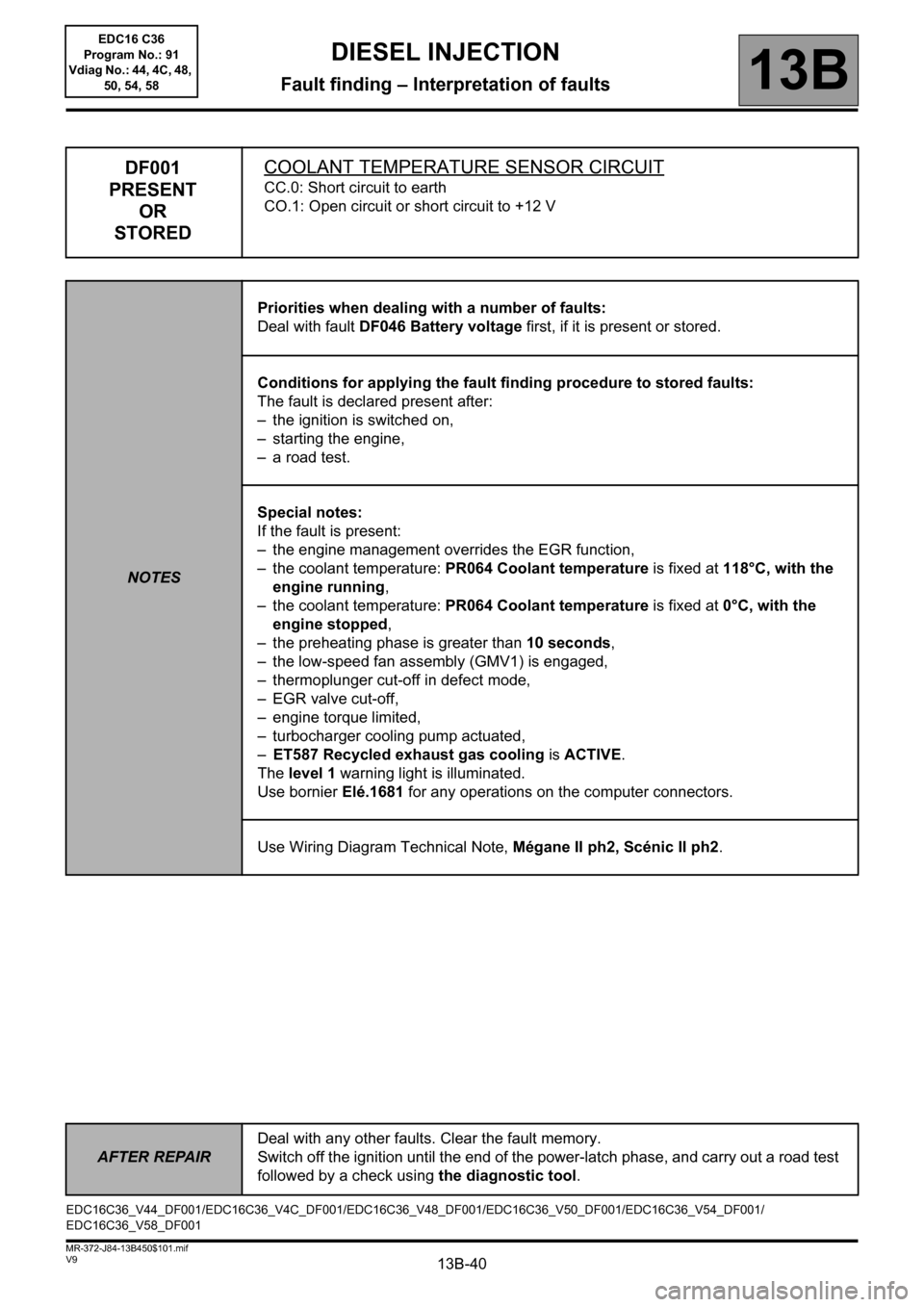
13B-40V9 MR-372-J84-13B450$101.mif
13B
DF001
PRESENT
OR
STOREDCOOLANT TEMPERATURE SENSOR CIRCUIT
CC.0: Short circuit to earth
CO.1: Open circuit or short circuit to +12 V
NOTESPriorities when dealing with a number of faults:
Deal with fault DF046 Battery voltage first, if it is present or stored.
Conditions for applying the fault finding procedure to stored faults:
The fault is declared present after:
– the ignition is switched on,
– starting the engine,
– a road test.
Special notes:
If the fault is present:
– the engine management overrides the EGR function,
– the coolant temperature: PR064 Coolant temperature is fixed at 118°C, with the
engine running,
– the coolant temperature: PR064 Coolant temperature is fixed at 0°C, with the
engine stopped,
– the preheating phase is greater than 10 seconds,
– the low-speed fan assembly (GMV1) is engaged,
– thermoplunger cut-off in defect mode,
– EGR valve cut-off,
– engine torque limited,
– turbocharger cooling pump actuated,
–ET587 Recycled exhaust gas cooling is ACTIVE.
The level 1 warning light is illuminated.
Use bornier Elé.1681 for any operations on the computer connectors.
Use Wiring Diagram Technical Note, Mégane II ph2, Scénic II ph2.
EDC16C36_V44_DF001/EDC16C36_V4C_DF001/EDC16C36_V48_DF001/EDC16C36_V50_DF001/EDC16C36_V54_DF001/
EDC16C36_V58_DF001
DIESEL INJECTION
Fault finding – Interpretation of faults
AFTER REPAIRDeal with any other faults. Clear the fault memory.
Switch off the ignition until the end of the power-latch phase, and carry out a road test
followed by a check using the diagnostic tool.
EDC16 C36
Program No.: 91
Vdiag No.: 44, 4C, 48,
50, 54, 58
Page 48 of 431
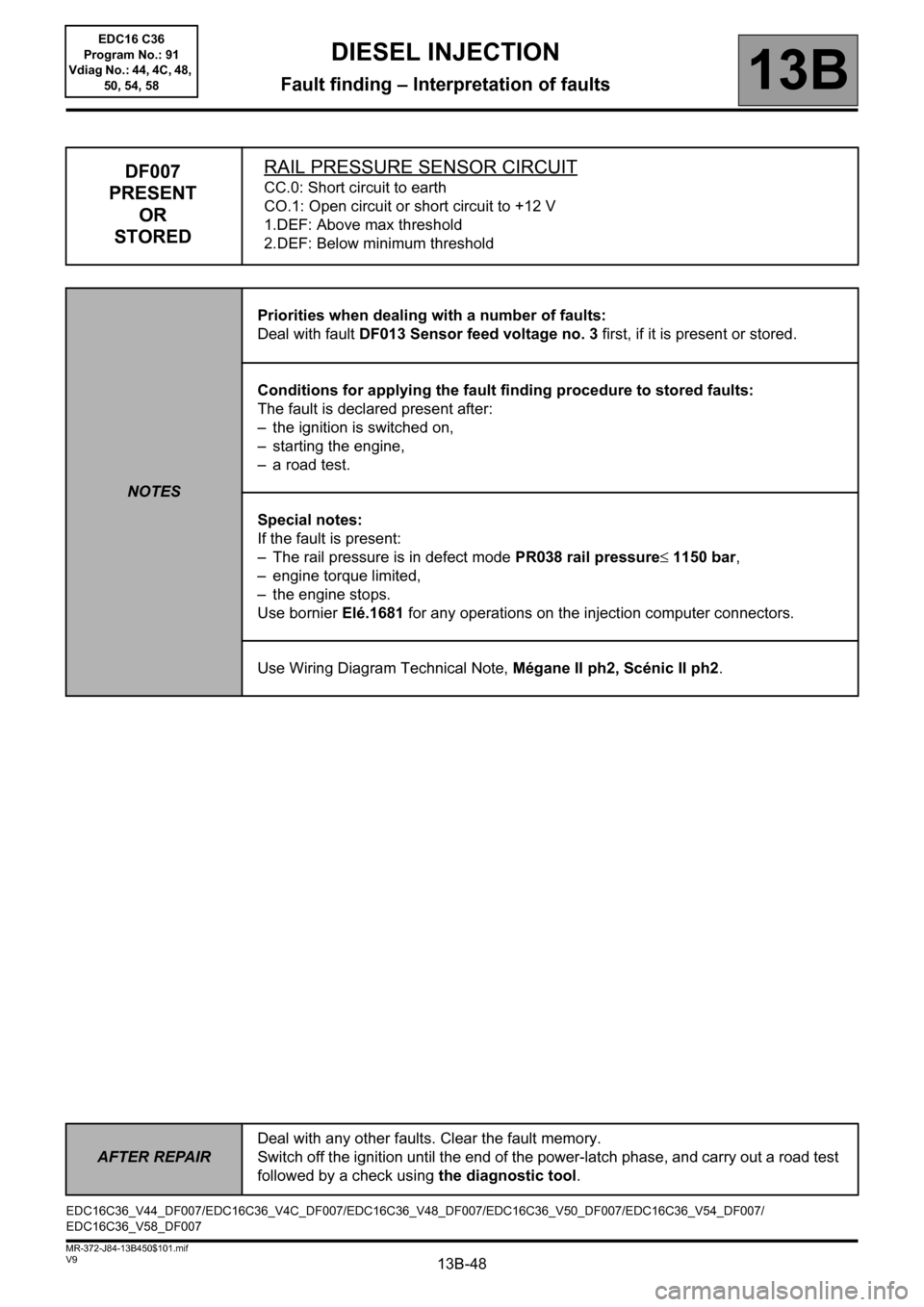
13B-48V9 MR-372-J84-13B450$101.mif
DIESEL INJECTION
Fault finding – Interpretation of faults13B
DF007
PRESENT
OR
STOREDRAIL PRESSURE SENSOR CIRCUITCC.0: Short circuit to earth
CO.1: Open circuit or short circuit to +12 V
1.DEF: Above max threshold
2.DEF: Below minimum threshold
NOTESPriorities when dealing with a number of faults:
Deal with fault DF013 Sensor feed voltage no. 3 first, if it is present or stored.
Conditions for applying the fault finding procedure to stored faults:
The fault is declared present after:
– the ignition is switched on,
– starting the engine,
– a road test.
Special notes:
If the fault is present:
– The rail pressure is in defect mode PR038 rail pressure≤ 1150 bar,
– engine torque limited,
– the engine stops.
Use bornier Elé.1681 for any operations on the injection computer connectors.
Use Wiring Diagram Technical Note, Mégane II ph2, Scénic II ph2.
EDC16C36_V44_DF007/EDC16C36_V4C_DF007/EDC16C36_V48_DF007/EDC16C36_V50_DF007/EDC16C36_V54_DF007/
EDC16C36_V58_DF007
AFTER REPAIRDeal with any other faults. Clear the fault memory.
Switch off the ignition until the end of the power-latch phase, and carry out a road test
followed by a check using the diagnostic tool.
EDC16 C36
Program No.: 91
Vdiag No.: 44, 4C, 48,
50, 54, 58
Page 51 of 431
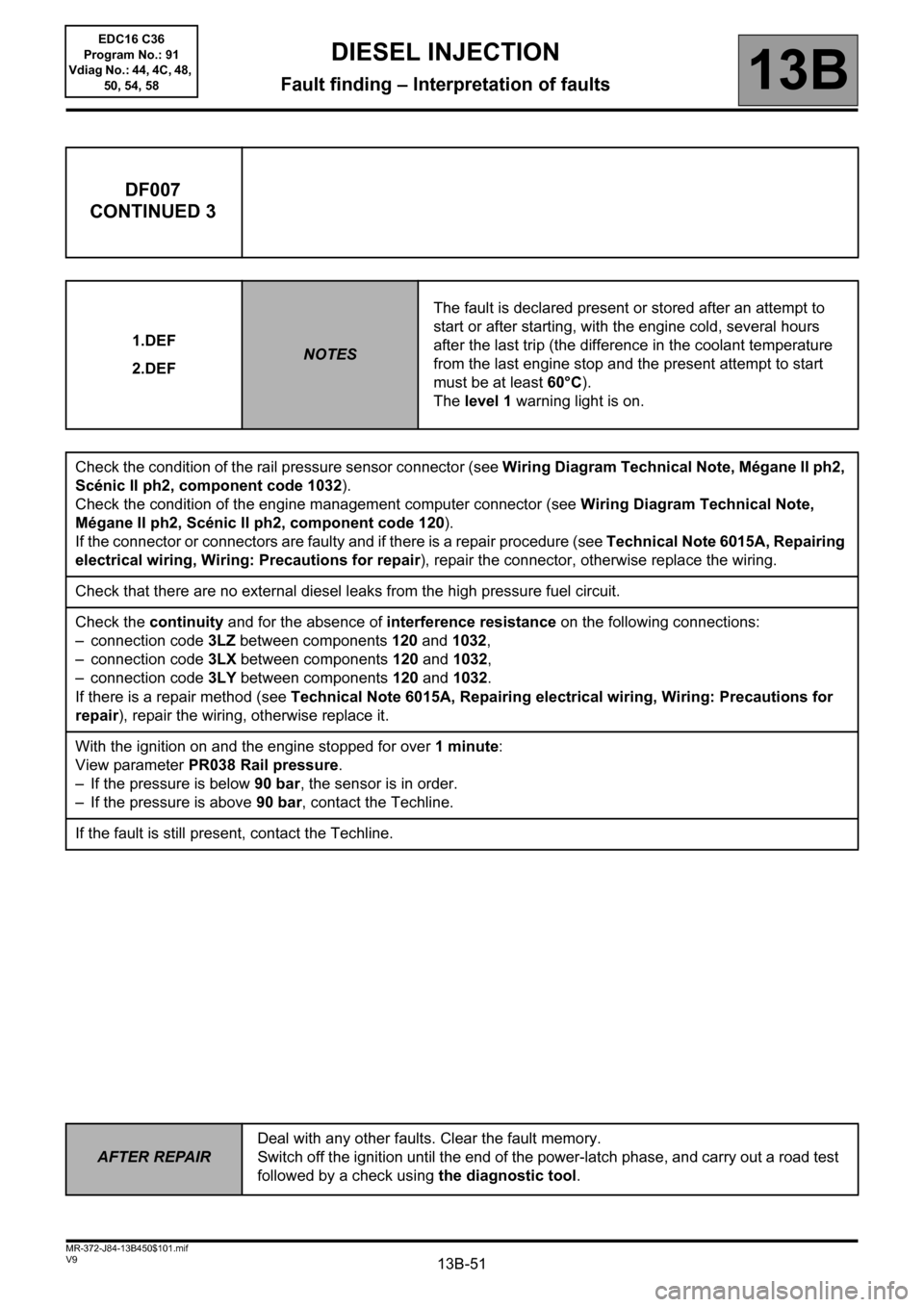
13B-51V9 MR-372-J84-13B450$101.mif
DIESEL INJECTION
Fault finding – Interpretation of faults13B
DF007
CONTINUED 3
1.DEF
2.DEFNOTESThe fault is declared present or stored after an attempt to
start or after starting, with the engine cold, several hours
after the last trip (the difference in the coolant temperature
from the last engine stop and the present attempt to start
must be at least 60°C).
The level 1 warning light is on.
Check the condition of the rail pressure sensor connector (see Wiring Diagram Technical Note, Mégane II ph2,
Scénic II ph2, component code 1032).
Check the condition of the engine management computer connector (see Wiring Diagram Technical Note,
Mégane II ph2, Scénic II ph2, component code 120).
If the connector or connectors are faulty and if there is a repair procedure (see Technical Note 6015A, Repairing
electrical wiring, Wiring: Precautions for repair), repair the connector, otherwise replace the wiring.
Check that there are no external diesel leaks from the high pressure fuel circuit.
Check the continuity and for the absence of interference resistance on the following connections:
– connection code 3LZ between components 120 and 1032,
– connection code 3LX between components 120 and 1032,
– connection code 3LY between components 120 and 1032.
If there is a repair method (see Technical Note 6015A, Repairing electrical wiring, Wiring: Precautions for
repair), repair the wiring, otherwise replace it.
With the ignition on and the engine stopped for over 1 minute:
View parameter PR038 Rail pressure.
– If the pressure is below 90 bar, the sensor is in order.
– If the pressure is above 90 bar, contact the Techline.
If the fault is still present, contact the Techline.
AFTER REPAIRDeal with any other faults. Clear the fault memory.
Switch off the ignition until the end of the power-latch phase, and carry out a road test
followed by a check using the diagnostic tool.
EDC16 C36
Program No.: 91
Vdiag No.: 44, 4C, 48,
50, 54, 58
Page 58 of 431
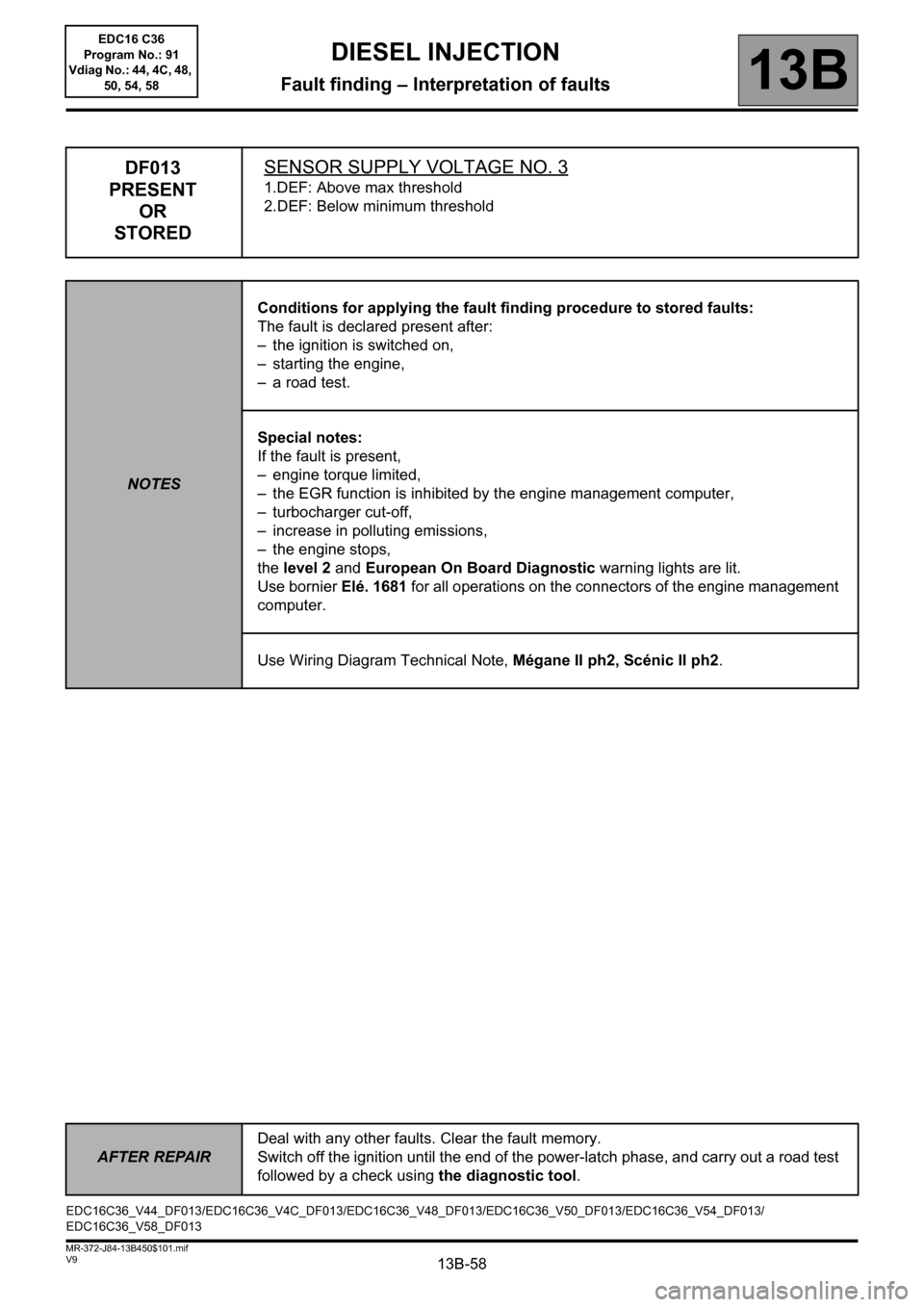
13B-58V9 MR-372-J84-13B450$101.mif
DIESEL INJECTION
Fault finding – Interpretation of faults13B
DF013
PRESENT
OR
STOREDSENSOR SUPPLY VOLTAGE NO. 3
1.DEF: Above max threshold
2.DEF: Below minimum threshold
NOTESConditions for applying the fault finding procedure to stored faults:
The fault is declared present after:
– the ignition is switched on,
– starting the engine,
– a road test.
Special notes:
If the fault is present,
– engine torque limited,
– the EGR function is inhibited by the engine management computer,
– turbocharger cut-off,
– increase in polluting emissions,
– the engine stops,
the level 2 and European On Board Diagnostic warning lights are lit.
Use bornier Elé. 1681 for all operations on the connectors of the engine management
computer.
Use Wiring Diagram Technical Note, Mégane II ph2, Scénic II ph2.
EDC16C36_V44_DF013/EDC16C36_V4C_DF013/EDC16C36_V48_DF013/EDC16C36_V50_DF013/EDC16C36_V54_DF013/
EDC16C36_V58_DF013
AFTER REPAIRDeal with any other faults. Clear the fault memory.
Switch off the ignition until the end of the power-latch phase, and carry out a road test
followed by a check using the diagnostic tool.
EDC16 C36
Program No.: 91
Vdiag No.: 44, 4C, 48,
50, 54, 58
Page 80 of 431
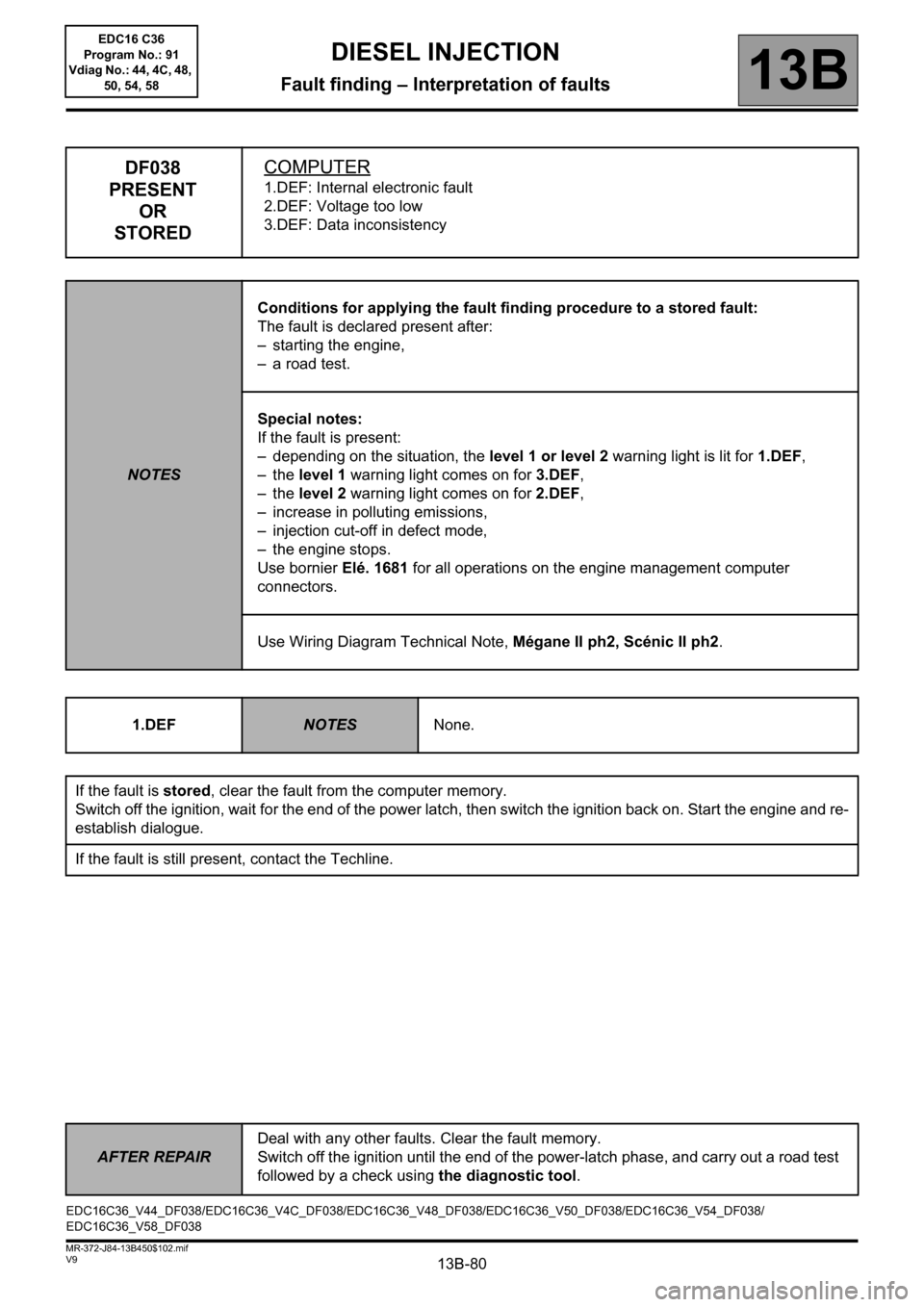
13B-80V9 MR-372-J84-13B450$102.mif
DIESEL INJECTION
Fault finding – Interpretation of faults13B
DF038
PRESENT
OR
STOREDCOMPUTER
1.DEF: Internal electronic fault
2.DEF: Voltage too low
3.DEF: Data inconsistency
NOTESConditions for applying the fault finding procedure to a stored fault:
The fault is declared present after:
– starting the engine,
– a road test.
Special notes:
If the fault is present:
– depending on the situation, the level 1 or level 2 warning light is lit for 1.DEF,
–the level 1 warning light comes on for 3.DEF,
–the level 2 warning light comes on for 2.DEF,
– increase in polluting emissions,
– injection cut-off in defect mode,
– the engine stops.
Use bornier Elé. 1681 for all operations on the engine management computer
connectors.
Use Wiring Diagram Technical Note, Mégane II ph2, Scénic II ph2.
1.DEF
NOTESNone.
If the fault is stored, clear the fault from the computer memory.
Switch off the ignition, wait for the end of the power latch, then switch the ignition back on. Start the engine and re-
establish dialogue.
If the fault is still present, contact the Techline.
EDC16C36_V44_DF038/EDC16C36_V4C_DF038/EDC16C36_V48_DF038/EDC16C36_V50_DF038/EDC16C36_V54_DF038/
EDC16C36_V58_DF038
AFTER REPAIRDeal with any other faults. Clear the fault memory.
Switch off the ignition until the end of the power-latch phase, and carry out a road test
followed by a check using the diagnostic tool.
EDC16 C36
Program No.: 91
Vdiag No.: 44, 4C, 48,
50, 54, 58
Page 86 of 431
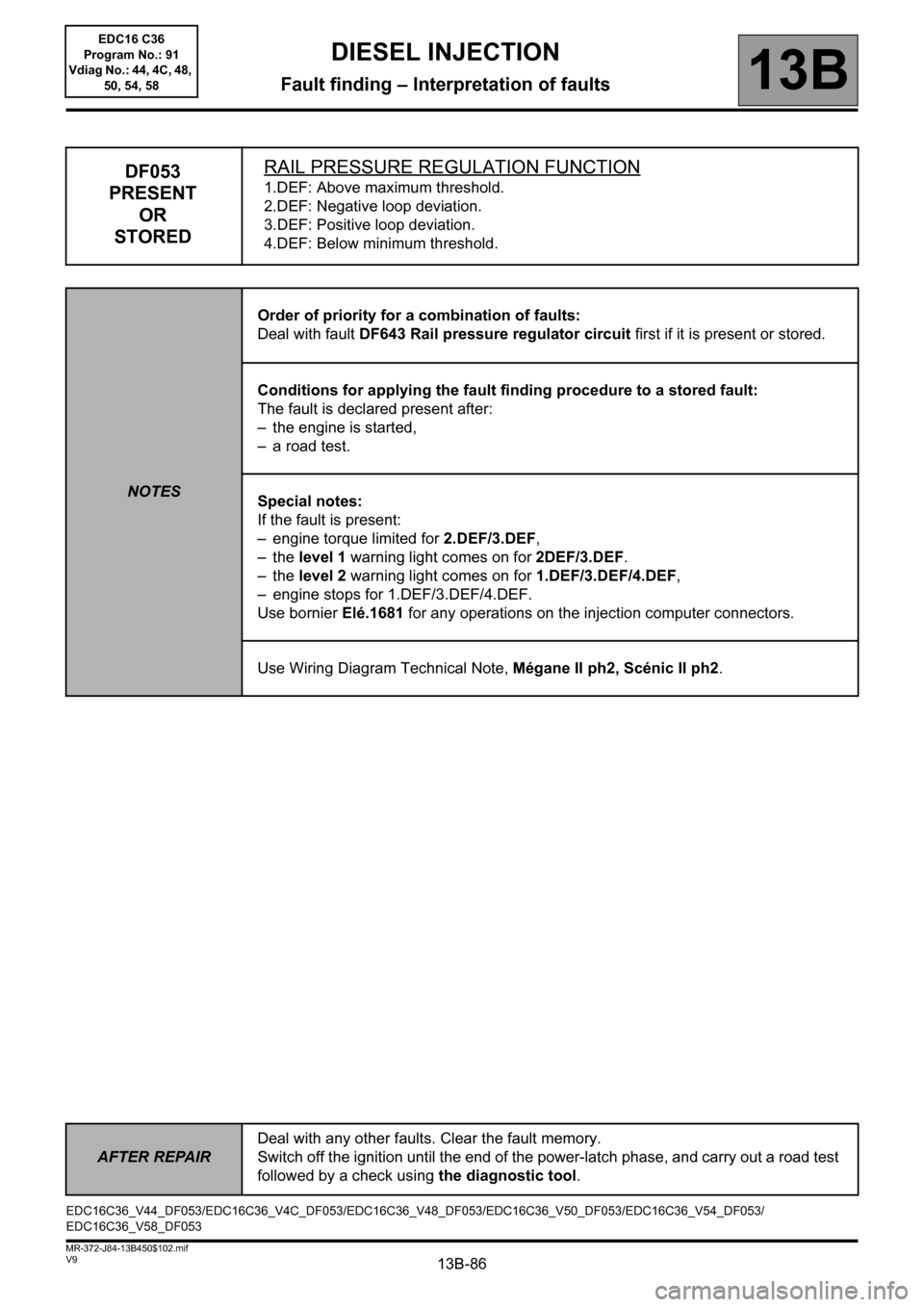
13B-86V9 MR-372-J84-13B450$102.mif
DIESEL INJECTION
Fault finding – Interpretation of faults13B
DF053
PRESENT
OR
STOREDRAIL PRESSURE REGULATION FUNCTION1.DEF: Above maximum threshold.
2.DEF: Negative loop deviation.
3.DEF: Positive loop deviation.
4.DEF: Below minimum threshold.
NOTESOrder of priority for a combination of faults:
Deal with fault DF643 Rail pressure regulator circuit first if it is present or stored.
Conditions for applying the fault finding procedure to a stored fault:
The fault is declared present after:
– the engine is started,
– a road test.
Special notes:
If the fault is present:
– engine torque limited for 2.DEF/3.DEF,
–the level 1 warning light comes on for 2DEF/3.DEF.
–the level 2 warning light comes on for 1.DEF/3.DEF/4.DEF,
– engine stops for 1.DEF/3.DEF/4.DEF.
Use bornier Elé.1681 for any operations on the injection computer connectors.
Use Wiring Diagram Technical Note, Mégane II ph2, Scénic II ph2.
EDC16C36_V44_DF053/EDC16C36_V4C_DF053/EDC16C36_V48_DF053/EDC16C36_V50_DF053/EDC16C36_V54_DF053/
EDC16C36_V58_DF053
AFTER REPAIRDeal with any other faults. Clear the fault memory.
Switch off the ignition until the end of the power-latch phase, and carry out a road test
followed by a check using the diagnostic tool.
EDC16 C36
Program No.: 91
Vdiag No.: 44, 4C, 48,
50, 54, 58
Page 120 of 431
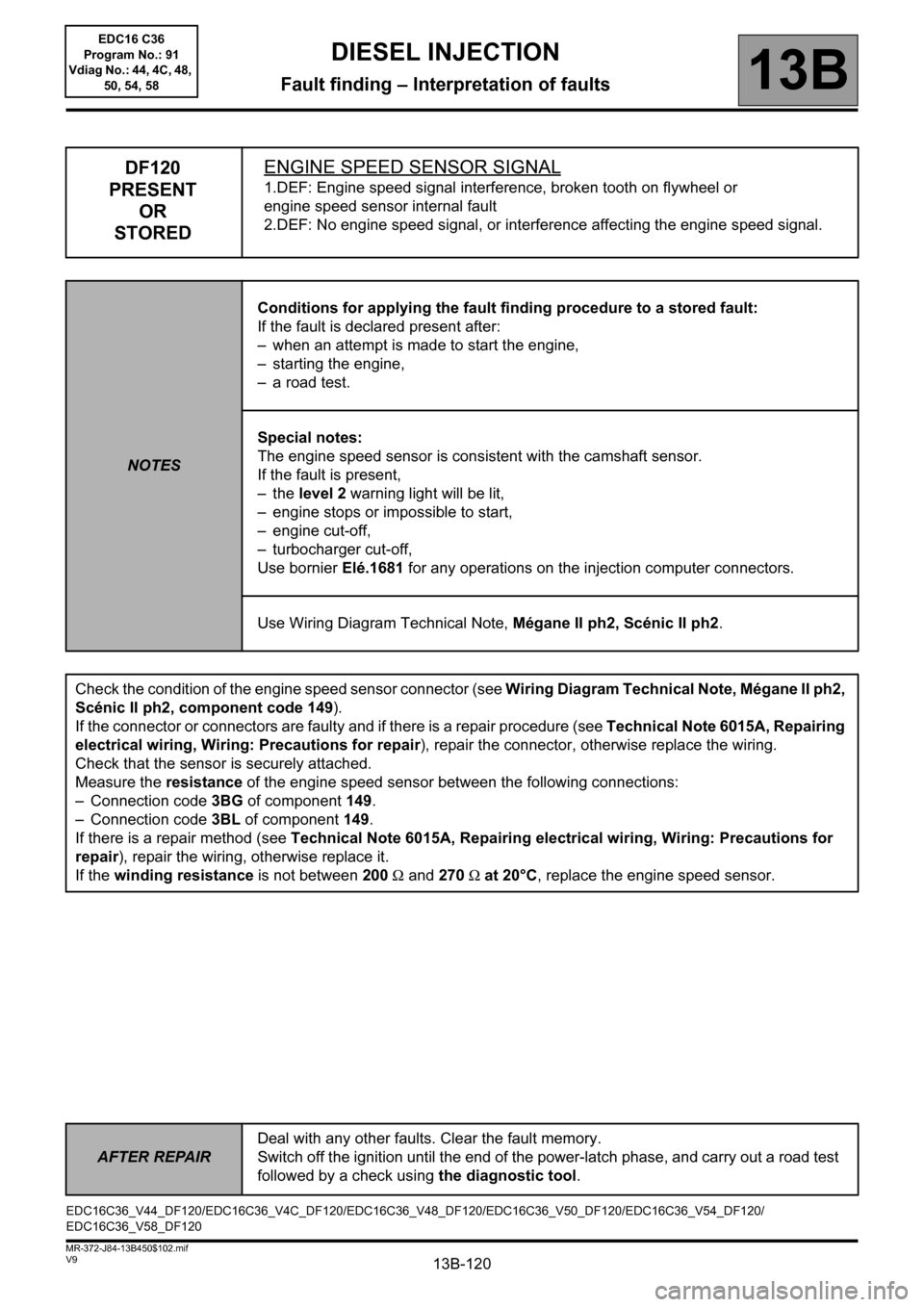
13B-120V9 MR-372-J84-13B450$102.mif
DIESEL INJECTION
Fault finding – Interpretation of faults13B
DF120
PRESENT
OR
STOREDENGINE SPEED SENSOR SIGNAL
1.DEF: Engine speed signal interference, broken tooth on flywheel or
engine speed sensor internal fault
2.DEF: No engine speed signal, or interference affecting the engine speed signal.
NOTESConditions for applying the fault finding procedure to a stored fault:
If the fault is declared present after:
– when an attempt is made to start the engine,
– starting the engine,
– a road test.
Special notes:
The engine speed sensor is consistent with the camshaft sensor.
If the fault is present,
–the level 2 warning light will be lit,
– engine stops or impossible to start,
– engine cut-off,
– turbocharger cut-off,
Use bornier Elé.1681 for any operations on the injection computer connectors.
Use Wiring Diagram Technical Note, Mégane II ph2, Scénic II ph2.
Check the condition of the engine speed sensor connector (see Wiring Diagram Technical Note, Mégane II ph2,
Scénic II ph2, component code 149).
If the connector or connectors are faulty and if there is a repair procedure (see Technical Note 6015A, Repairing
electrical wiring, Wiring: Precautions for repair), repair the connector, otherwise replace the wiring.
Check that the sensor is securely attached.
Measure the resistance of the engine speed sensor between the following connections:
– Connection code 3BG of component 149.
– Connection code 3BL of component 149.
If there is a repair method (see Technical Note 6015A, Repairing electrical wiring, Wiring: Precautions for
repair), repair the wiring, otherwise replace it.
If the winding resistance is not between 200 Ω and 270 Ω at 20°C, replace the engine speed sensor.
EDC16C36_V44_DF120/EDC16C36_V4C_DF120/EDC16C36_V48_DF120/EDC16C36_V50_DF120/EDC16C36_V54_DF120/
EDC16C36_V58_DF120
AFTER REPAIRDeal with any other faults. Clear the fault memory.
Switch off the ignition until the end of the power-latch phase, and carry out a road test
followed by a check using the diagnostic tool.
EDC16 C36
Program No.: 91
Vdiag No.: 44, 4C, 48,
50, 54, 58